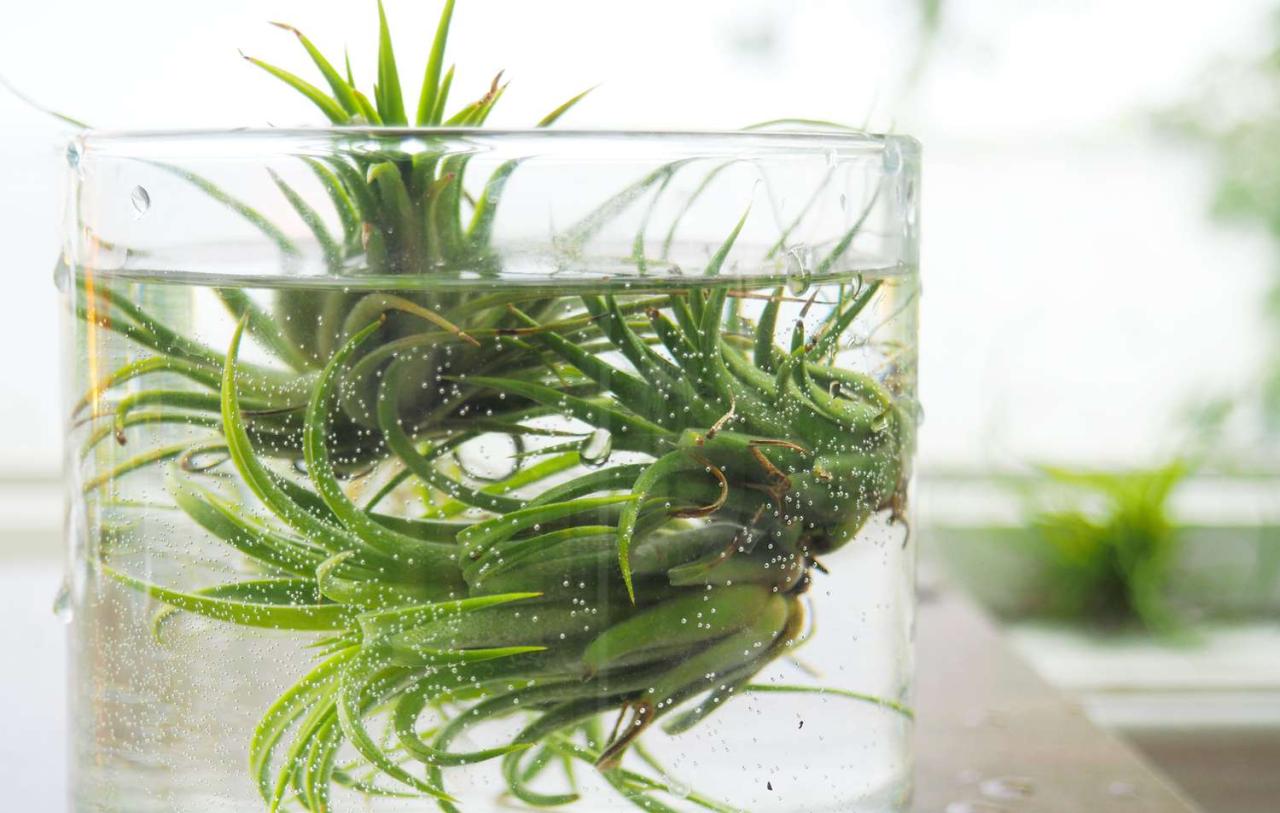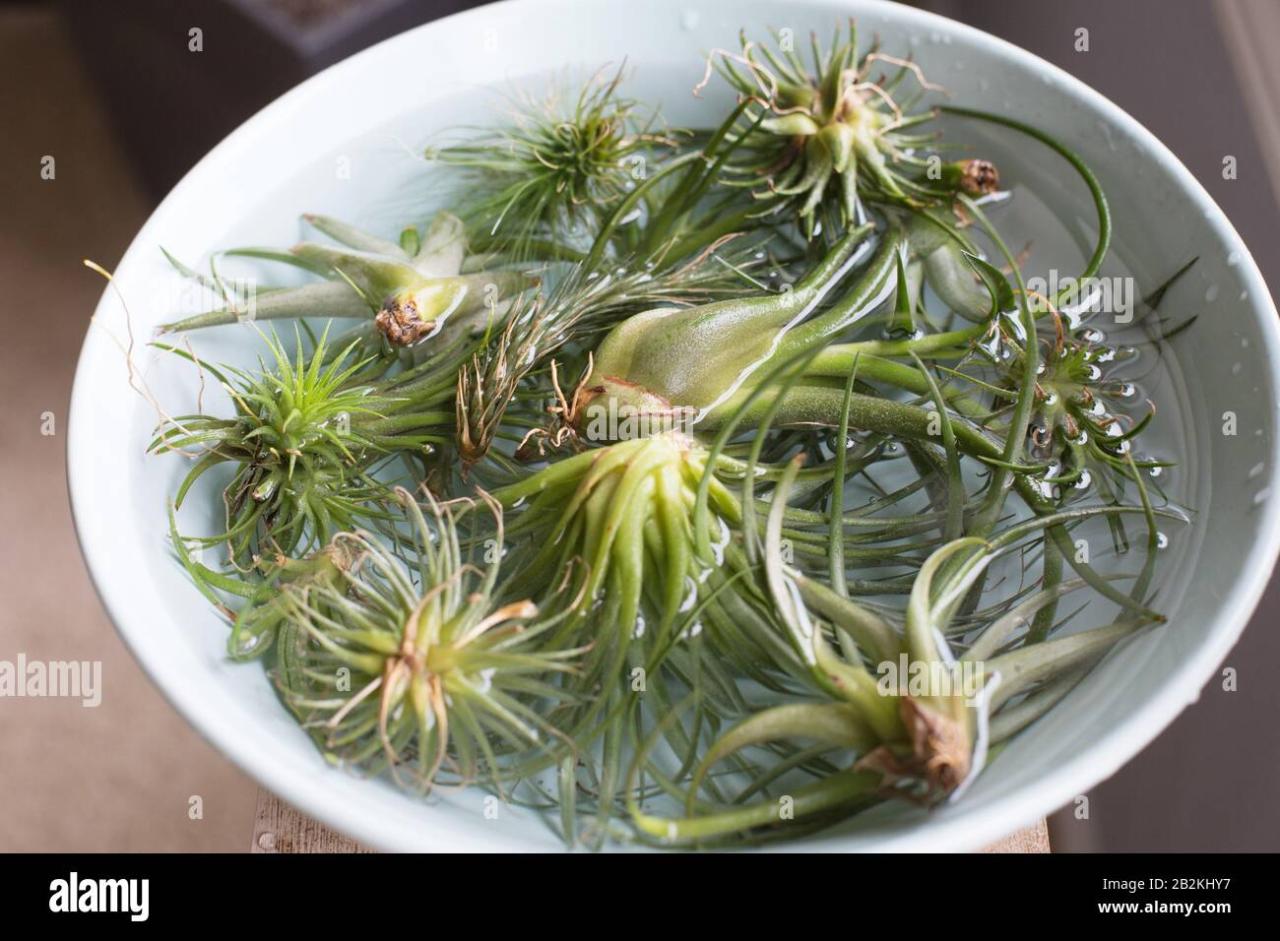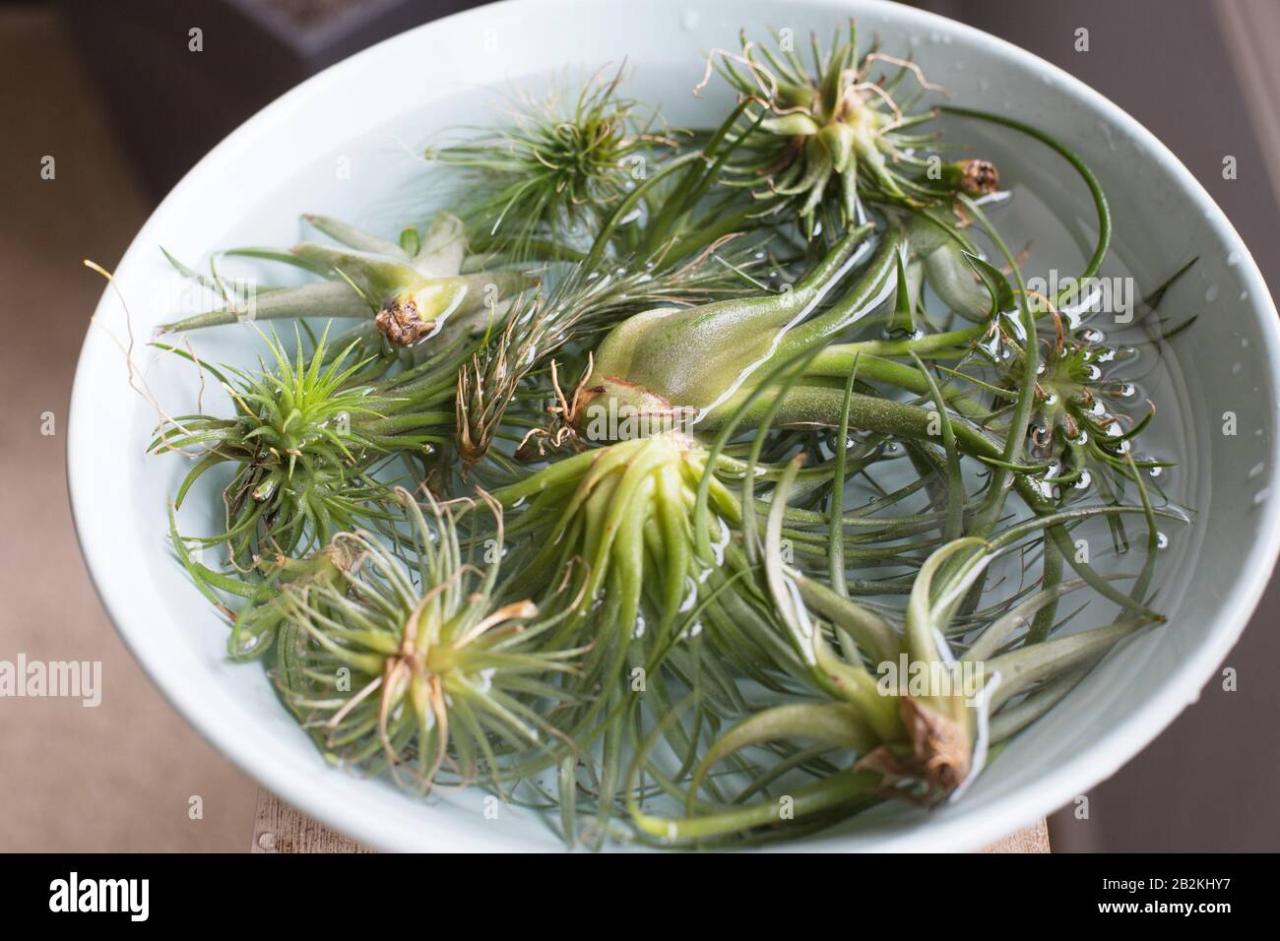How to Properly Dunk Air Plants for Watering is a crucial skill for any air plant enthusiast. These fascinating plants, unlike their terrestrial counterparts, absorb moisture primarily through their leaves, relying on atmospheric humidity. Their unique structure, featuring specialized trichomes, allows them to capture and absorb water from the air.
However, proper watering techniques are essential for their well-being, and dunking emerges as a popular and effective method. This guide delves into the art of dunking air plants, offering a step-by-step process to ensure optimal hydration while avoiding common pitfalls.
Understanding the intricacies of air plant watering is key to their thriving. Unlike traditional plants, air plants draw moisture from the air through specialized structures on their leaves called trichomes. These trichomes act like tiny sponges, absorbing water vapor from the atmosphere.
While air plants can absorb some moisture from the air, regular watering is still crucial for their survival. Dunking, a popular method, involves submerging the air plant in water for a specific period. This allows the plant to fully absorb water through its leaves, ensuring optimal hydration.
Understanding Air Plants and Their Watering Needs

Air plants, also known as epiphytes, are fascinating plants that have adapted to thrive without soil. Instead of relying on roots to absorb water and nutrients, they absorb moisture directly from the air. This unique characteristic makes them incredibly adaptable and popular among plant enthusiasts.
When dunking air plants for watering, ensure the water is room temperature and free of contaminants. This is especially important if you are battling pesky gnats, which can be attracted to stagnant water. To combat these insects, consider introducing natural predators like ladybugs or lacewings, as outlined in this helpful guide: Best Natural Predators for Gnats in Your Plants.
After soaking, allow your air plants to dry thoroughly to prevent rot, ensuring a healthy and thriving environment for your unique plants.
The Role of Trichomes in Water Absorption
Air plants have specialized structures called trichomes that cover their leaves. These trichomes act like tiny hairs, absorbing moisture from the air through a process called capillarity. When water droplets come into contact with the trichomes, they are drawn up into the plant’s tissues.
This allows air plants to access the moisture they need to survive in environments with limited access to soil.
Watering Requirements for Different Air Plant Species
The watering requirements for air plants vary depending on the species. Some air plants, like the Tillandsia ionantha, are relatively drought-tolerant and can go for several weeks without being watered. Others, like the Tillandsia xerographica, require more frequent watering, especially during hot and dry periods.
The Importance of Proper Dunking
Dunking is the most common and recommended method for watering air plants, providing a thorough and efficient way to hydrate them. It’s a simple process that mimics the natural way air plants absorb moisture from the environment, offering several advantages over other watering techniques.
When watering air plants, dunking them in a bowl of water for 15-30 minutes is the most effective method. This allows the plant to absorb moisture through its leaves, but it’s important to ensure the plant dries completely after soaking to prevent root rot.
To make this process easier, especially if you have multiple air plants, consider using tools like watering cans with long spouts or handheld misters, which can be helpful for reaching those hard-to-access areas. You can find a comprehensive list of the best tools for taking care of hanging plants, including air plants, in this helpful guide.
After the soaking, allow the plant to air dry thoroughly before returning it to its holder or display, and remember to avoid using hard water as this can leave mineral deposits on the leaves.
Benefits of Dunking Air Plants
Dunking air plants offers numerous benefits over other watering methods, ensuring optimal hydration and promoting healthy growth.
- Thorough Hydration:Dunking completely immerses the plant in water, allowing it to absorb moisture through its trichomes, the tiny scales covering its leaves. This ensures that all parts of the plant are adequately hydrated, unlike misting, which only provides surface moisture.
- Convenience:Dunking is a quick and easy method, requiring minimal effort. Simply submerge the plant in a bowl of water for a few minutes, and you’re done. It’s a hassle-free way to keep your air plants hydrated.
- Nutrient Delivery:When using a water-soluble fertilizer, dunking allows for efficient nutrient delivery to the plant. The fertilizer dissolves in the water, and the plant absorbs it directly through its trichomes.
- Reduces Risk of Rot:While overwatering can lead to rot, proper dunking techniques minimize this risk. The plant absorbs the water it needs, and the excess drains away, preventing the build-up of moisture that can cause rot.
Risks Associated with Overwatering Air Plants Through Dunking
While dunking is generally safe, overwatering can pose a threat to air plants. Excessive water exposure can lead to root rot and other problems.
- Root Rot:Prolonged soaking or dunking in water can suffocate the roots, leading to root rot. This is a common problem in air plants that are overwatered, as the roots need oxygen to thrive.
- Bacterial and Fungal Infections:Excessive moisture can create a breeding ground for bacteria and fungi, which can infect the plant and cause disease.
- Leaf Damage:Overwatering can also lead to leaf damage. The leaves may become soft, mushy, and discolored, eventually turning brown and dying.
Choosing the Right Water for Dunking
The type of water you use for dunking is crucial for the health of your air plants. Avoid using tap water, which often contains chlorine, fluoride, and other chemicals that can harm plants.
- Rainwater:Rainwater is the ideal choice for dunking air plants, as it’s naturally soft and free of harmful chemicals. Collect rainwater in a clean container to use for watering.
- Distilled Water:Distilled water is another good option, as it’s free of impurities. It’s readily available at most grocery stores.
- Filtered Water:Filtered water can also be used for dunking, but make sure the filter removes chlorine and other harmful chemicals.
The Dunking Process

Now that we understand the importance of proper dunking for air plants, let’s delve into the step-by-step process.
Step-by-Step Guide to Dunking Air Plants
This section will provide a comprehensive guide to properly dunking your air plants, ensuring they receive the hydration they need.
Step |
Description |
|---|---|
1. Selecting a Suitable Container |
Choose a container that is large enough to comfortably hold the air plant and allow it to be fully submerged in water. A bowl, bucket, or even a sink can be used. The container should be clean and free of any chemicals or residues that could harm the plant. |
2. Filling the Container with Water |
Fill the container with room temperature water. It’s crucial to use water that is not too hot or too cold, as extreme temperatures can shock the plant. |
3. Submerging the Air Plant |
Gently submerge the air plant in the water, ensuring that the entire plant is immersed. Avoid pressing or forcing the plant underwater, as this could damage the delicate leaves. |
4. Soaking Time Recommendations |
The soaking time depends on the size and type of air plant. Generally, smaller air plants require 20-30 minutes of soaking, while larger plants may need 30-60 minutes. It’s best to observe the plant’s leaves. If they appear plump and hydrated after 20-30 minutes, you can remove the plant. However, if they still seem dry, continue soaking for another 10-15 minutes. |
5. Removing the Air Plant from the Water |
After the recommended soaking time, gently lift the air plant out of the water. Avoid squeezing or twisting the plant, as this can damage the leaves. |
6. Drying the Air Plant |
Allow the air plant to thoroughly dry before returning it to its usual location. This typically takes 2-4 hours, depending on the air circulation and humidity levels. Make sure to dry the plant upside down to prevent water from accumulating in the center of the plant, which can lead to rot. |
Post-Dunking Care
Proper post-dunking care is crucial for the health and well-being of your air plant. Just like any other plant, air plants require a specific environment to thrive. After soaking, it’s essential to ensure they dry thoroughly and are placed in an environment that promotes their well-being.
Inspecting for Excess Water
After removing the air plant from the water, it’s crucial to inspect it for any excess water. Excess water can lead to rot and fungal growth, which can harm your air plant.
- Gently shake the air plant to remove any excess water that may be trapped in its leaves or base.
- If you notice any water pooling at the base of the air plant, use a paper towel to gently absorb it.
- Avoid squeezing the air plant too tightly, as this can damage its delicate leaves.
Allowing the Air Plant to Dry Completely
Once you’ve removed any excess water, it’s essential to allow the air plant to dry completely. This is a critical step in preventing rot and promoting healthy growth.
- Place the air plant in a well-ventilated area, away from direct sunlight.
- Allow the air plant to dry completely, which may take several hours, depending on the size and humidity levels.
- Avoid placing the air plant in a sealed container or plastic bag, as this can trap moisture and lead to rot.
Providing Proper Air Circulation
Air plants thrive in environments with good air circulation. This helps them to dry quickly and prevents the buildup of moisture that can lead to rot.
- Place the air plant in a location with good airflow, such as near a window or fan.
- Avoid placing the air plant in a stagnant or humid environment.
- Consider using a small fan to create air circulation around the air plant.
Selecting the Appropriate Location for the Air Plant
Choosing the right location for your air plant is crucial for its health and well-being.
- Air plants prefer bright, indirect sunlight.
- Avoid placing them in direct sunlight, as this can scorch their leaves.
- Consider hanging the air plant from a hook or placing it on a shelf to provide good air circulation and prevent moisture buildup.
Alternative Watering Methods for Air Plants
While dunking is the most common and effective method for watering air plants, alternative methods exist, each with its own advantages and disadvantages. Understanding these methods allows you to choose the best approach for your specific air plant species and environmental conditions.
Misting, How to Properly Dunk Air Plants for Watering
Misting involves spraying air plants with fine water droplets. It’s a convenient method for quick hydration, especially for smaller plants or those with delicate leaves. However, misting alone is often insufficient for thorough hydration, particularly in dry environments.
Misting is best used as a supplementary watering method alongside dunking or soaking, especially for air plants with fine, delicate leaves.
Soaking
Soaking involves immersing air plants in a bowl of water for a set period. This method allows for deeper hydration and is suitable for larger air plants or those with thick, absorbent leaves. However, over-soaking can lead to root rot, so careful monitoring is crucial.
Soaking is an effective method for thorough hydration but requires careful monitoring to prevent over-soaking.
Rainwater Collection
Rainwater is naturally soft and free of minerals, making it ideal for watering air plants. Collecting rainwater in a container allows for a readily available source of water for your plants. However, this method relies on rainfall, making it less reliable in dry climates.
Rainwater is an excellent choice for watering air plants, but its availability is dependent on rainfall patterns.
Final Wrap-Up: How To Properly Dunk Air Plants For Watering
Mastering the art of dunking air plants requires a delicate balance between providing adequate hydration and preventing overwatering. By understanding the unique characteristics of these fascinating plants and following the Artikeld steps, you can ensure their health and vitality. Remember, proper dunking techniques are essential for maintaining the well-being of your air plants, allowing them to flourish in their unique environment.
FAQs
How often should I dunk my air plants?
The frequency of dunking depends on the specific air plant species, environmental conditions, and the plant’s overall health. Generally, dunking once every 1-2 weeks is sufficient, but some species may require more frequent watering.
What happens if I overwater my air plants by dunking?
Overwatering air plants through dunking can lead to root rot and other fungal issues. The excess water can trap moisture around the plant’s base, creating a breeding ground for bacteria and fungi. To avoid overwatering, ensure the plant dries completely after each dunking session.
Can I use tap water to dunk my air plants?
While tap water is often used, it’s best to avoid using water that contains chlorine or fluoride, as these chemicals can harm air plants. Opt for filtered water, rainwater, or distilled water for optimal results.
